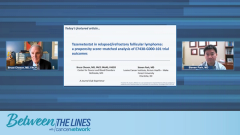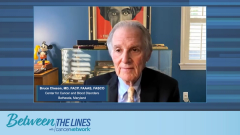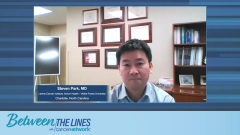
Relapsed/Refractory Follicular Lymphoma Overview and Treatment Options
Opening their discussion on relapsed/refractory follicular lymphoma (R/R FL), expert participants review the spectrum of available treatments in this setting.
Transcript:
Bruce Cheson, MD, FACP, FAAAS, FASCO: Welcome to this CancerNetwork® Between the Lines program. Today’s featured article is “Tazemetostat in Relapsed/Refractory Follicular Lymphoma: a Propensity Score–Matched Analysis of E7438-G000-101 Trial Outcomes.” I’m Dr Bruce Cheson, and I will be discussing this publication with my colleague, Dr Steven Park. Dr Park, who are the typical patients with relapsed/refractory follicular lymphoma that you see in your practice? How do they usually present?
Steven Park, MD: Well, let me thank you for inviting me, and it’s very nice to join this discussion. [I will] start with follicular lymphoma, which is one of the most common types of indolent lymphoma. Patients with follicular lymphoma present with fever, chills, drenching night sweats, and weight loss, which are called B symptoms. Actually, these symptoms are not relatively common, and the majority of patients with follicular lymphoma do not have any significant symptoms other than enlarged lymph nodes at their presentation.
Bruce Cheson, MD, FACP, FAAAS, FASCO: When they have those symptoms, I guess we usually are concerned they might have transformed to an aggressive lymphoma.
Steven Park, MD: That’s right. If they present with B symptoms, then especially we also look at their laboratory test results, and if they have elevated LDH [lactate dehydrogenase], that goes along with concern for transformed disease. Then also on imaging studies, on the PET [positron emission tomography] scan, if they have high max SUVs [standardized uptake values] then yes, we tend to worry about any particular transformation.
Bruce Cheson, MD, FACP, FAAAS, FASCO: We tend to divide these patients into 2 basic groups, based on when they have their progression of disease, whether it’s within 24 months, the so-called POD24. How does the prognosis of those 2 groups of patients differ?
Steven Park, MD: Follicular lymphoma is very heterogeneous, and as you mentioned, it seems to be [that] there are at least 2 very different prognostic groups. We used to use the FLIPI [Follicular Lymphoma International Prognostic Index] score, and based on the scoring system, we predicted their prognosis. But more recently [we use] the POD24; depending on their length of remission, if they have this progression within 24 months of their initial therapy, they tend to have a much worse prognosis. Really, their prognosis depends on their response to initial therapy. If they achieve more than 20 months of remission, then it appears that their prognosis is similar, [and] their life expectancy is similar to those who do not have the diagnosis of lymphoma.
Bruce Cheson, MD, FACP, FAAAS, FASCO: You’re right. Now, the drug we’re going be talking about today, tazemetostat, targets EZH2. Can you give us an idea of what the role of EZH2 is in the pathogenesis of follicular lymphoma?
Steven Park, MD: Yes. EZH2 is one of the most commonly mutated genes in lymphoma, including follicular lymphoma. I would say approximately 20% to 30% of patients with follicular lymphoma harbor this mutation. EZH2 is part of PRC2 complex, which leads to gene repression. It turns out that overexpression of EZH2 interferes with cancer suppressor genes and can lead to cancer progression and more aggressive behaviors, including in patients with lymphoma.
Bruce Cheson, MD, FACP, FAAAS, FASCO: When we have a patient with relapsed or refractory follicular lymphoma, we have a number of treatment options we can offer them. That number has decreased considerably recently with the flushing of the PI3 kinase inhibitors. What other drugs and classes of drugs do you most commonly use in the relapsed/refractory population, and how do you decide how to sequence them?
Steven Park, MD: We just talked about the heterogeneity of follicular lymphoma, and I think it depends on multiple factors. We talked about the POD24. If the patient has any sort of aggressively behaving lymphoma, in that case, I think we tend to be more aggressive, and we think about stem cell transplant. More recently, we think about CAR [chimeric antigen receptor] T-cell therapy, which is now approved for relapsed/refractory follicular lymphoma after 2 lines of therapy. I think that is a special population where we think about [a] more aggressive approach up front. For patients with routine, indolent follicular lymphoma, then it depends on their baseline functional status, their age, their comorbidities, and many other factors that we look at. Let’s say we commonly use R [rituximab]-chemotherapy for the frontline, like rituximab-bendamustine. In that case, we look into using other rituximab-chemotherapy like R-CHOP [rituximab plus cyclophosphamide, doxorubicin, vincristine, and prednisone] as a second-line [therapy], if the patient receives rituximab-bendamustine. Or we consider rituximab-lenalidomide in patients who are not great candidates for more aggressive R-CHOP chemotherapy.
Transcript edited for clarity.
Newsletter
Stay up to date on recent advances in the multidisciplinary approach to cancer.




































































































